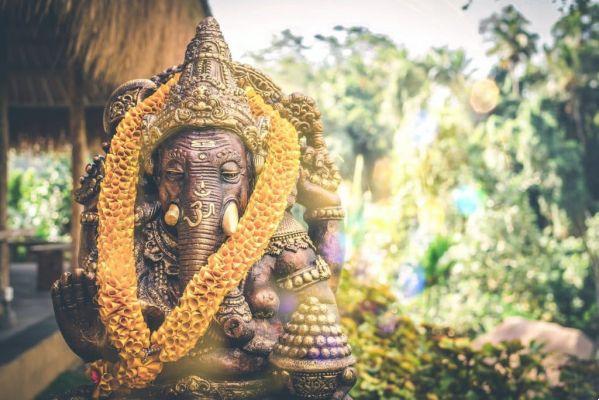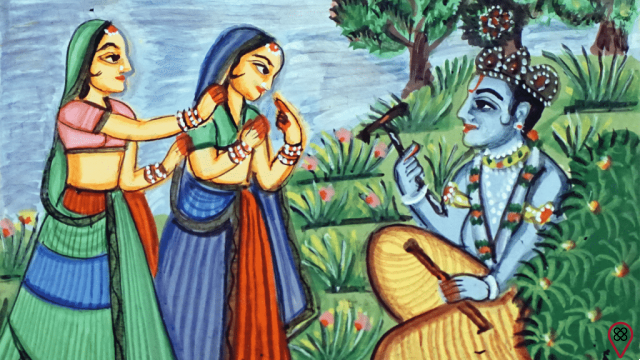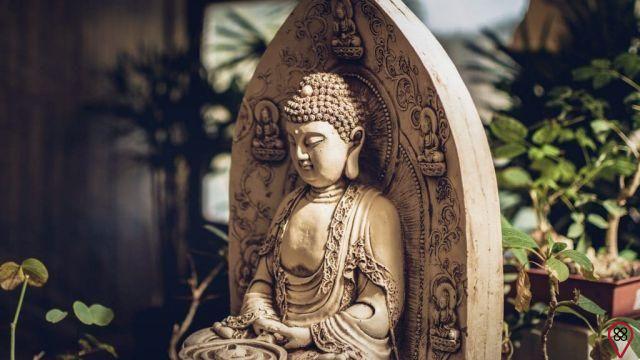Anyone who follows the Hindu religion knows Bhagavad-Gita very well and knows that it is a work of extreme importance. It is the most revered text by Hindus and provides fundamental lessons for anyone, whether or not a follower of Hinduism.
Bhagavad-Gita means "Sublime Song", "the song (Gita) of God (Bhagavan) or even "song of the blessed" and originates from Vedic Sanskrit - ancient Indian language, language of the Vedas, which are the oldest texts from the set of rules and principles of the Hindu scriptures.
It is a chapter of the Mahabharata, one of the longest classic Indian epics. The Mahabharata is considered among practitioners as the most important sacred text of Hinduism and discusses the three goals of human life (trivarga): dharma (what defines the moral and social order of all beings), artha ( sustenance, economic development ) and kama (experience of every form of pleasure).
After fulfilling these goals, man is able to attain moksha, that is, spiritual enlightenment or fulfillment. The three goals are like stepping stones to moksha.

What does Bhagavad-Gita say?
Despite being a small chapter of the Mahabharata, Bhagavad-Gita manages to transpose, in its short verses, the teachings of all the Vedas. In its 18 chapters, the work narrates a conversation between the warrior Arjuna and Krishna, on a battlefield. Explained in incidents prior to the Bhagavad-Gita, this battle took place between the families of two brothers, Dhritarashtra and Pandu, heirs to the throne. As Dhritarashtra was born blind, Pandu assumed the kingship.
Each had his family and heirs (the Pandavas, descendants of Pandu; and the Kauravas, descendants of Dhritarashtra). The conflict begins when the ambitious Duryodhana, son of Dhritarashtra, tries at all costs to defeat the Pandavas after Pandu's death. After several failed attempts, the war between the cousins breaks out.
The work is a dialogue between Arjuna and Krishna – who is the chariot driver of the young warrior. Early on, Arjuna asks Krishna to take him into the middle of the fight, where he can then study his opponents. He is soon surprised when he finds his own loved ones on the other side of the battle.

In the midst of a real internal crisis, Arjuna becomes completely paralyzed, his body trembles, his mouth goes dry. How to fight your own kin? But what if you don't fight? These are two conditions that, for him, would also bring suffering, since Arjuna is basically the representation of dharma – that is, of what is right (as opposed to his cousin Duryodhana, who goes totally in the opposite direction of dharma). But if he fulfills his obligation, he will have to kill several of his relatives, even if it is to do the right thing.
The young warrior then decides to give up the fight, since he cannot fight against those he loves, and asks Krishna the reasons why he needs to face his own relatives, a task for which he thinks he has no strength. And then, to assuage this suffering by making any decision, the young man asks Krishna for a light, in search of a decision that avoids suffering.
To Arjuna's surprise, Krishna then explains the real meaning of the battle: it is an internal conflict, which we face in our daily lives and is the result of our existential problems. Throughout the 18 chapters of Bhagavad-Gita, Krishna teaches about yoga and its values.
the symbologies
Arjuna often questions his own ability to win – or even to enter the fight. He represents each one of us, because we also live questioning if we are capable, if we are prepared.
Your questions are our questions in the face of life, the fear of making decisions, of getting rid of some addictions, of doing what is right, even if it comes at a cost. Because choosing is winning and losing.
Krishna, as chariot driver, symbolizes knowledge, which guides the warrior on his journey.

The Pandavas are our essential qualities, values, our most noble. In contrast, the Kauravas are our bad dispositions, defects, faults. It would be easy to deliberate if we looked “from the outside” at Pandavas and Kauravas, but inside, they are parts of us that we cultivate and have our affections for, even though we know they are not good for us.
That's why it becomes very difficult to kick a bad habit. And even though it is harmful in almost every moment of our life, its existence is important for us to value and strengthen our virtues.
The values of yoga mentioned in the work
The illustrious dialogue between Arjuna and Krishna contained in this very essential chapter of the Mahabharata teaches perennial values, timeless and devoid of subjectivity, what we can call ethics. Or, as we mentioned briefly above, dharma. Essential values for anyone, under any circumstances, regardless of religion (or non-religion), philosophy of life, time or region.
These values, as well portrayed by Swami Dayananda Saraswati, in his book “The Value of Values”, are the “qualities that the seeker's mind must have in order to reach the knowledge of the Self”.
In this work, Saraswati talks about them in a schematic way, and here we will summarize so that you can understand a little about what Arjuna is taught in his journey of decisions, as well as being able to make them a guide for your own journey. These values make up what we might call the Krishna Code:

1. Amanitvam: absence of vanity, arrogance or need to be praised;
2. Adambhitvam: absence of pretense;
3. Ahiṁsā: non-violence;
4. Kṣānti: peaceful adaptability;
5. Arjavam: righteousness;
6. Acāryopāsanam: dedication to the master;
7. Śauchan: purification;
8. Sthairyam: firmness of purpose;
9. Atma-vinigraha: command over thought;
10. Indriyartheśu vairāgyam: detachment from sense objects;
11. Anahaṅkāra: absence of identification with things of the ego;
12. Janmamṛtyujaravyādhiduḥkhadośānudarśanam: reflection on the limitations of birth, death, old age, illness and pain;
13. Aśakti: absence of attachment to the idea of possession;
14. Anabiśvaṅgaḥ putradaragṛhādiśu: affective equanimity;
15. Nityam samacittatvam iśtaniṣṭopapattiṣu: equanimidade constante;
16. Bhaktir avyabhicāriṇī: unshakable devotion;
17. Viviktadeśa sevitvam: appreciation for a quiet place;
18. Aratiḥ janasamsadi: appreciation for solitude;
19. Tattvajñānārthadarśanam: focus and clarity in truth;
20. Adhyātmajñāna nityatvaṁ: continuous disposition towards self-knowledge.
In order for you to get a light on how to find the path of evolution, you have to keep in mind what choices will be made, and this carries the weight of consequences, whatever your decision.
Fight your battles, don't be deceived by the comfort of the status quo, especially its flaws, because they install themselves more easily, as they often present you with shortcuts to "solve" life's issues.
You may also like
- Pay attention to the 4 laws of spirituality taught in India
- Understand what the OM symbol means and what it's for!
- Discover the Indian Gods and their connections to Hinduism
We must act responsibly and conscientiously, assuming all our actions, but always tending to do what is right, always seeking to improve as human beings. Because this, although apparently longer and more laborious, is the only possible path.

























